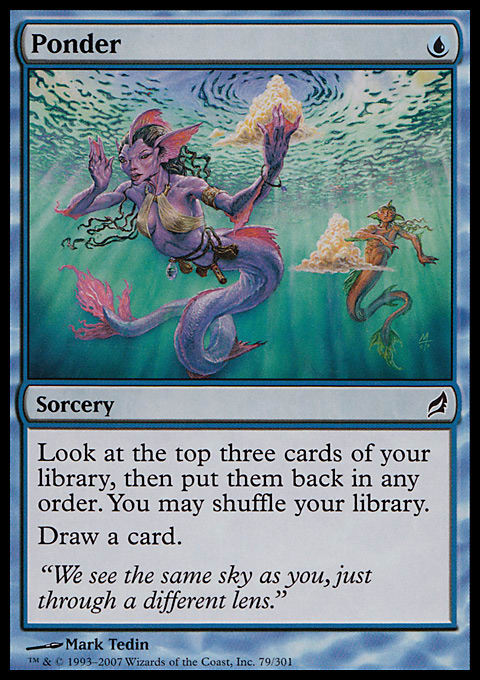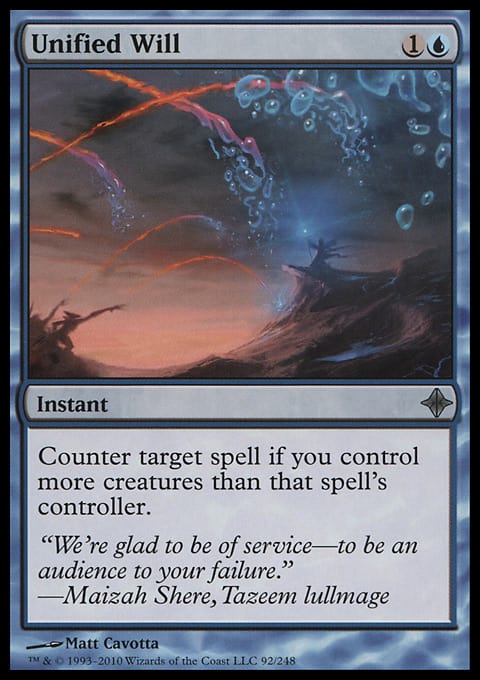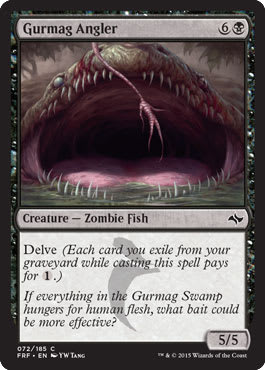This past weekend, I was fortunate to be able to team with Adam Yurchick and Frank Vanderwall for the recent Team Constructed SCG Open in Baltimore. This first tournament of its kind was memorable for a number of reasons, not the least of which being that it brought me my first opportunity in over a month to scratch my competitive Legacy itch! Of course, there was the fact that team tournaments are awesome, and that there are few better feelings in Magic than losing your match only to look over and see that both of your teammates covered for you. Oh, and we should all take notice of the fact that the tournament capped at 300 teams (900 participants) and there were still likely 50-100 more teams that would have signed up had they not been capped. These are eye-opening figures. The simple truth is, team tournaments are not only the future of the SCG Tour, but also probably the future of competitive Magic as a whole. Let’s digress briefly into why that is, before jumping into the Legacy deck I played and the Legacy brewing I’m currently doing with the tournament as hindsight.
Okay, so everybody knows that team tournaments are fun. Part of that is their novelty, but part of it is the fact that fundamentally, individual Magic tournaments are a solitary experience. You do not get to experience the same tournament as anyone else, so there is less room for the kind of excitement and energy that accompany team sports. Think back to when you were a kid, playing youth sports. The camaraderie, teamwork, and nervous energy of a big game were incomparable in terms of the heightened emotional state that you experienced there and nowhere else in your young life. Many people come to Magic to engage in competition after their youth sports careers sadly end, but there is a distinct difference between the single combat of normal Magic and the team effort of three-person tournaments. Team tournaments rekindle just a little bit of that youth-sports spark that many seek out in Magic. Win, and you have friends to celebrate with you. Lose, and you can commiserate with those who feel the same pain, who shared the exact same experience. When you’re invested in others’ success as much as your own, it adds a new dimension of emotion to a Magic tournament, and that is something the tournament organizing bodies are only now starting to embrace. Clearly, we know that team Magic is just plain more exciting and enjoyable than one-on-one Magic, and it’s not just the novelty (though the novelty did contribute to the off-the-charts interest in the tournament).
Let’s get a bit more theoretical for a moment, though. Magic’s biggest competitors, the games that we see breaking through to large sponsorships and mainstream success, are by-and-large e-sports. League of Legends comes to mind as the primary example of this phenomenon, and part of the excitement of broadcast League of Legends games is in the team narrative that the commentators promote. With the introduction of the Pro Tour Team Series, it seems like Wizards of the Coast is listening and experimenting with a similar narrative, but that still doesn’t allow lower-level competitors the opportunity to experience anything remotely similar. Watching and rooting for your favorite team is one thing, like with professional sports. Being able to form your own team and battle against other teams in an attempt to all win together is, if you’ll excuse the obvious metaphor, a whole different ballgame. Part of the appeal of Magic is that you can, if you work at it, play on the Pro Tour. That’s basically the whole selling point of Premier Events, of Organized Play. What if you could pursue that dream with your friends, working together and breaking through to the next level together? Well, that makes customer retention a whole lot more likely, to put it in corporate lingo. More team events are the natural evolution of the Team Series to better compete with Magic’s biggest competitors, and the fact that Wizards and SCG are only now trying this is actually mind-boggling, when you stop and consider all of the benefits of team Magic.
Incidentally, the Classics the next day at the Open were bursting at the seams, because the 276 teams that didn’t make day two still each had a Standard, Modern, and Legacy player equipped with the same deck they played the day before. Plus, because they all booked hotel rooms together and traveled together, there was a lower chance that individual players would skip the second-day events and head home early. All of this translates into — I can only speculate — record profits for SCG. Remember how StarCityGames cut the Player’s Championships because Cedric admitted that the SCG Tour was not particularly profitable? Well, I can only assume that this weekend saw them clearly in the black, and the customers were happy to pay for the experience.
It would not surprise me at all to see multiple Team Constructed stops on the SCG Tour in the second half of the year, nor would it surprise me to see at least half a dozen Team Constructed GPs in 2018. Should the Team Constructed SCG events continue to sell out at record pace, I would hope that for next year Cedric Phillips and the SCG Tour folks consider making their own Team Series with a large end-of-year grudge match to replace the fallen Players’ Championship. I know I’d travel cross-country for a Team Open, and I’m not the only one. Honestly, I would probably fly to Siberia to play in a Standard-Modern-Legacy Team Constructed Grand Prix if they had it, so if Helene Bergeot and the various bigwigs at WoTC are listening, I hope I’m being especially loud and clear.
“Okay, okay! We get it, Ben. Team Magic is sweet, and we cannot wait to play in more team events. But why Standard-Modern-Legacy over something like Team Unified Modern?” Well, here’s the deal with Unified Constructed. Although it’s cool that there are new deck-building restrictions and new room to get creative, part of the appeal of watching and reading coverage is that a viewer can look at the winning deck and use it as a starting point for their own testing and play at their local FNM. Ever wonder why people love watching Constructed but hate watching Limited (and the numbers on stream viewership bear this out)? People want to see what interesting decks others have made, to see if they would like to play a similar strategy. In Limited play, you can simply never count on playing the same deck as the one you saw on stream, and that diminishes the ability of the viewer to see themselves in the shoes of the players on camera. Team Unified suffers from the same phenomenon, to a lesser extent. The decklists are all perfectly legal, but they are often constructed in such a way as to make them frequently slightly suboptimal for individual play. In Unified Modern specifically, linear decks get a huge benefit because there is only a one in three chance of playing against a specific hate card. Think Stony Silence vs. Affinity, or Rest in Peace vs. Dredge.
The solution, of course, is as elegant as it is simple. With three different formats, not only are the decklists as “real” as any individual tournament, but devotees of every format have a reason to tune in! I can’t overstate how important this is. Those Legacy-only sharks are just as excited to watch coverage as the fresh-faced Standard FNM player, which has never happened before in the history of Magic. There’s something for everyone from a coverage standpoint, there are amazing team narratives that directly address major competitors to Magic, and viewers can organize their own teams to do battle together (increasing the likelihood that all three team members stick with Magic). I’ll say it just once before we move on to a more strategically interesting topic.
THIS IS THE BEST THING TO HAPPEN TO MAGIC IN YEARS. WHAT IN THE WORLD TOOK SO LONG??
Okay, so now that my brief rant about the untapped gold mine of team tournaments is over, we can get into the nitty-gritty of my own tournament and the Delve Delver deck that I played to an uninspiring finish.
I was thrilled to be the Legacy player on the team, and while Adam grinded out B/G in Standard, and Frank battled with various Tron decks in Modern, I got to hunker down in the lab with my time-tested Delver strategies. During the week leading up to the tournament, I started practicing with my various incarnations of 4-Color Delver, some with different numbers of removal, trying Fatal Push, trying straight Sultai, more True-Name Nemesis, maindeck Kolaghan's Command, you get the picture. The conclusions I came to were as follows:
- Playing Hymn to Tourach in your Sultai Delver deck is okay, but you will be making your mana base at least as bad as the four-color version. Playing two Bayou in your deck with Daze is just asking for trouble. Twenty lands solves the problem a little bit, but not much. Still, it’s powerful against combo decks.
- You probably want to play Lightning Bolt over Fatal Push if you’re playing a lower-to-the-ground version of Delver, with a few True-Name Nemesis and multiple Gurmag Anglers.
- Gurmag Angler is still the best threat in the deck, and it got so much better with the printing of Fatal Push, it’s insane. It is foolish to play Tarmogoyf in this format. I never thought I’d say those words.
- I had a string of 3-2 and 2-3 finishes before finally 5-0ing a League with a version of Delve Delver, so I had to lock in four Gurmag Angler and play with good ol’ Thought Scour. Plus, I won the last Legacy tournament I played in Baltimore with Delve Delver, so why not try it again?
Here’s the list I ended up playing in the tournament:
Delve Delver ? Legacy | Ben Friedman
- Creatures (14)
- 2 True-Name Nemesis
- 4 Deathrite Shaman
- 4 Gurmag Angler
- 4 Delver of Secrets
- Instants (23)
- 2 Abrupt Decay
- 2 Spell Pierce
- 3 Thought Scour
- 4 Brainstorm
- 4 Daze
- 4 Force of Will
- 4 Lightning Bolt
- Sorceries (4)
- 4 Ponder
- Lands (19)
- 1 Badlands
- 1 Volcanic Island
- 2 Tropical Island
- 3 Underground Sea
- 4 Polluted Delta
- 4 Scalding Tarn
- 4 Wasteland
- Sideboard (15)
- 1 Abrupt Decay
- 2 Diabolic Edict
- 2 Invasive Surgery
- 1 Painful Truths
- 2 Pithing Needle
- 1 Snapcaster Mage
- 3 Surgical Extraction
- 3 Thoughtseize
Surprisingly, I had a rough patch against several combo decks, losing to B/r Reanimator, Sneak and Show, and Tin Fins (the latter two losses cost my team our Day 2 berth). I also lost to Sam Pardee after a non-game for Game 1 and a nailbiter for Game 2. I beat some Storm decks, the mirror match, Miracles, and one other Sneak and Show deck, but overall I was disappointed with my combo matchup with what I thought should have been a heavily favored deck. Now, granted, I believe that with different lines I could have beaten two out of the three combo decks I ended up facing, but I’m going to have to rethink how I want to approach those matchups.
Delver has been surprisingly underwhelming, and Gurmag Angler has been insane. The difference between tapping out on turn one and tapping one of your three lands on turn three to cast your threat is huge, and the Gurmag often closes the game out in three turns compared to Delver’s six. I love being able to sequence Thoughtseize into Daze into Thought Scour + Gurmag Angler, or a similar line, but I watched Delvers get Pyroblasted, Pyroclasmed, and otherwise rendered irrelevant repeatedly over the course of the tournament. I’m not trying to see my clock get taken offline, and I’m going to rely on the big fish along with a heavier discard and counterspell suite to do more of the heavy lifting in both the combo and Delver matchups in the future.
Additionally, my soft counters (specifically Daze) were surprisingly irrelevant a large percentage of the time, which left me with only the Force of Wills as true disruption. I hate having to hope that my opponent gets mana-screwed to actually win, especially when my Wastelands look silly staring down two basic lands from Storm or Show and Tell decks. I want my counters to be Counterspell, Spell Snare, Invasive Surgery, or Force of Will more than Spell Pierce, Daze, or Flusterstorm. More than that, I want a bunch of Thoughtseizes for good, clean discard along with a healthy dose of information on what I’ll need to counter. With Fatal Push in the picture, Snapcaster Mage can dump Swords to Plowshares and Stoneforge Mystic, and pick up Deathrite Shaman, Gurmag Angler, Thought Scour and Fatal Push as the new group of best friends. It’s sad to see White dumped so unceremoniously, but this is what happens when the best one-mana creature of all time is a B/G hybrid card, and the best new removal spell is a way, way better Disfigure. Where Shardless Sultai relied on Shardless Agent and Tarmogoyf, I want Snapcaster Mage and Gurmag Angler as my heavy hitters. I won’t have Ancestral Vision, but I’ll have Painful Truths, which is almost as good. Hell, if I’m feeling frisky I might just put a Fact or Fiction in my 75. Then the sparks will really start to fly. I assume if you ever Snapcaster Mage a Fact or Fiction, your opponent is obligated to concede on the spot. Regardless, be on the lookout for Shardless-less Sultai and Gurmag Grixis to make appearances in future articles and videos, and maybe you can be your team’s Legacy champion at the next Team Constructed tournament. Here’s to hoping it comes sooner rather than later!
— Ben






























